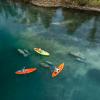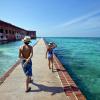By Steve Winston
The Coral Castle of Miami, a man's hand-built shrine, is one of South Florida's great head-scratching mysteries and attractions.
Sitting behind an old, neon-lined road south of Miami is America's most poignant monument to unrequited love, the Coral Castle of Florida.
The story of the Coral Castle, though, starts in the early 1900s in the Eastern European country of Latvia, where 26-year-old Edward Leedskalnin fell in love with 16-year-old Agnes Scuffs. They courted and eventually set a wedding date, but Agnes got cold feet the day before and called it off.
Heartbroken, Leedskalnin immigrated to America, settling in Florida City, a small, isolated town at the southern tip of Florida. He then spent the rest of his life creating a monument to the woman he loved.
He never really had a profession. But he did have an obsession.
In 1923, Leedskalnin began carving from the coral found under the soil of his property. During the next 28 years, he diligently and secretly sculpted 1,100 tons of coral into an open-air “castle,” a structure that became a shrine to Agnes. To ensure total privacy, he worked only at night, and filled in the cracks between the stones in the wall – the largest stone weighed 29 tons – with smaller stones so no one could see in during the day.
In 1936, Leedskalnin, concerned about the growth of Florida City, decided to move the castle 10 miles north to Homestead. It took Leedskalnin – who was only about 5 feet tall and 100 pounds – three years to move the castle piece by piece.
But how did a man of his stature transport tons of coral? Leedskalnin is said to have been a self-taught student of physics and was fascinated by ancient structures such as the pyramids, whose pieces were transported and constructed without modern methods.
As one story goes, Leedskalnin pulled into a local quarry one night to buy several tons of coral. When the foreman asked how he planned to load the coral into his old truck, Leedskalnin asked the man to turn his back. A few minutes later, the foreman turned around and was astonished to see Leedskalnin sitting in the truck with the coral fully loaded.
The sculptures Leedskalin crafted are no less impressive than the stories behind them. At the entrance to the Coral Castle of Florida, an inscription greets visitors: “You will be seeing unusual accomplishment.” And as promised, the site is full of magnificent sculptures, including a 9-ton gate that once moved with just the touch of a finger and rocking chairs made entirely of stone.
The castle sits on three acres, and the structure itself, consisting of walls 8 feet tall, takes up just less an acre. It is divided into several sections, including a two-story stone tower where Leedskalnin lived (without running water or electricity). The cramped top floor was his living quarters. The bottom floor was a storage area for his cutting and shaping tools (blocks, tackles, crude winches and wedges – most of which he made himself), along with equipment for radiowave, physics and astronomy experiments.
On the grounds, you'll see a 13-ton, 20-foot-long table, surrounded by 10 chairs, that Leedskalnin carved into the shape of Florida. You'll see the stone sundial he used to tell time. You'll see his moon fountain and sun couch. You'll see the Grotto of Three Bears, a children's play area. You'll see the stone well from which Leedskalnin drew his water, including the steps he used to check his water supply.
In a throne room sits his 5-ton rocking chair. And next to it are smaller thrones for Agnes, a child and a mother-in-law. Fascinated by astronomy and engrossed by the celestial, Leedskalnin also built a 30-ton telescope, which stands 25 feet tall, and focused it on the North Star.
Leedskalnin never gave up hope that he and Agnes would reunite, so he carved a 2.5-ton heart-shaped table for them to sit at. He invited her several times to see the castle, but she never came.
In 1951, a month or two after he finished the castle, he woke up one morning feeling ill. Leedskalnin, who rarely visited the doctor, put a sign on his door that said he was going to the hospital. He took a bus up U.S. 1 to Jackson Memorial Hospital in downtown Miami.
Three days later, he died of kidney failure and stomach cancer.
The castle he created, however, lives on as America's greatest monument to lost love.
If You Go
Coral Castle Museum, 28655 S Dixie Highway, Miami, is open seven days a week beginning at 8 a.m. Admission for adults is $12; children 7-12 are $7. Children 6 and under are free. Call 305-248-6345 or visit coralcastle.com.





















